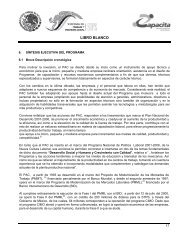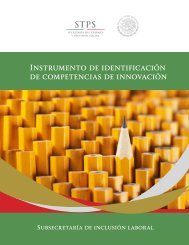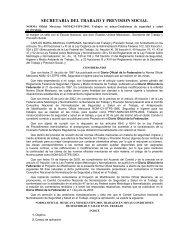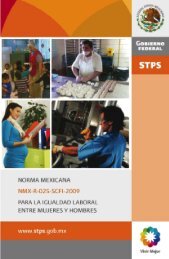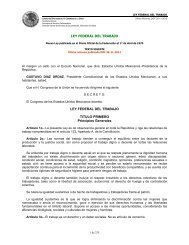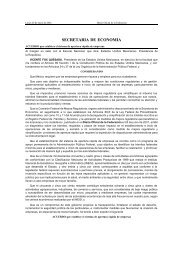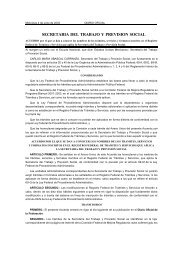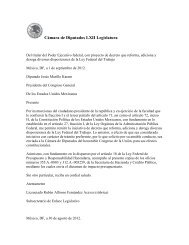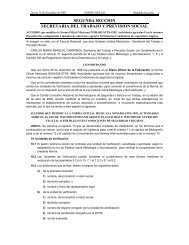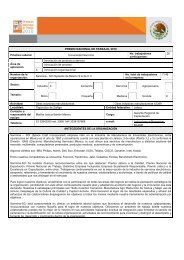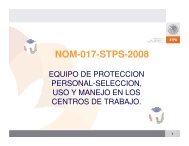- Page 1 and 2:
SECRETARIA DEL TRABAJO Y PREVISION
- Page 3 and 4:
NOM-114-STPS-1994, Sistema para la
- Page 5 and 6:
Ci ti es la medida i del contaminan
- Page 7 and 8:
3 EXPOSICION FRECUENTE A ALTAS CONC
- Page 9 and 10:
8.2 Selección de métodos analíti
- Page 11 and 12:
0.5
- Page 13 and 14:
I.1 La tabla I.1 contiene el listad
- Page 15 and 16:
66 AMONIACO 7664-41-7 25 18 35 27 6
- Page 17 and 18:
124 2-CIANOACRILATO DE METILO 137-0
- Page 19 and 20:
181 DIETILFTALATO 84-66-2 - 5 - 10
- Page 21 and 22:
245 DISULFURO DE CARBONO 75-15-0 PI
- Page 23 and 24:
316 FOSFORO, TRICLORURO DE 7719-12-
- Page 25 and 26:
377 METIL CICLOHEXANO 108-87-2 400
- Page 27 and 28:
Como polvo total - 0.5 - - Fracció
- Page 29 and 30:
490 TALCO (sin fibras de asbesto) 1
- Page 31 and 32:
547 TUNGSTENO Y COMPUESTOS (como W)
- Page 33 and 34:
fluoruro con objeto de dar un índi
- Page 35 and 36:
C1 C C ≤1 , 2 ≤1 ,... n ≤1 LM
- Page 37 and 38:
004 DETERMINACION DE NIEBLA DE ACEI
- Page 39 and 40:
PROCEDIMIENTO 001: DETERMINACION DE
- Page 41 and 42:
9. Calibración y patrones 9.1 Prec
- Page 43 and 44:
6. Ventajas y desventajas 6.1 Venta
- Page 45 and 46:
a) sustraer los valores de referenc
- Page 47 and 48:
5) válvulas reductoras de presión
- Page 49 and 50:
11.1 Leer el peso en mg correspondi
- Page 51 and 52:
) enjuagar totalmente con acetona,
- Page 53 and 54:
298 es la temperatura normal en K.
- Page 55 and 56:
9.2 Calibración de bombas de muest
- Page 57 and 58:
4. Precisión y exactitud El métod
- Page 59 and 60:
c) se recomienda que dos burbujeado
- Page 61 and 62:
11.3 La concentración de formaldeh
- Page 63 and 64:
de carbón activado de 20/40 mallas
- Page 65 and 66:
demuestre que da una reproductibili
- Page 67 and 68:
PROCEDIMIENTO 008: DETERMINACION DE
- Page 69 and 70:
) columna de acero inoxidable de 2.
- Page 71 and 72:
c) se deben hacer inyecciones dupli
- Page 73 and 74:
T es la temperatura en (ºC) del ai
- Page 75 and 76:
c) un integrador electrónico o alg
- Page 77 and 78:
manera, excepto que no se le añade
- Page 79 and 80:
cantidades mucho más pequeñas, si
- Page 81 and 82:
9.3.10 Se debe enviar al laboratori
- Page 83 and 84:
11. Cálculos 11.1 Leer el peso, en
- Page 85 and 86:
cromatográficas. Los tubos se anal
- Page 87 and 88:
d) 498 K (225°C) Temperatura del i
- Page 89 and 90:
donde: ppm = ⎛ mg ⎞ ⎜ ⎛ 24.
- Page 91 and 92:
7.7 Microjeringas de 10 μl y otros
- Page 93 and 94:
mismo lote que aquél usado en la o
- Page 95 and 96:
cuantificar cantidades mucho más p
- Page 97 and 98:
9.3.9 Un tubo debe ser manejado de
- Page 99 and 100:
11.2 Deben hacerse correcciones par
- Page 101 and 102:
la misma muestra, mediante un simpl
- Page 103 and 104:
f) 343 K (70ºC) temperatura de col
- Page 105 and 106:
PM es el peso molecular del triclor
- Page 107 and 108:
7.6 Contenedores de muestra de 2 ml
- Page 109 and 110:
flama. Este carbón activado debe s
- Page 111 and 112:
2.4 Se determina el área del pico
- Page 113 and 114:
9.3.4 El aire que está siendo mues
- Page 115 and 116:
interés, bajo las mismas condicion
- Page 117 and 118:
6.1 Ventajas. El aparato de muestre
- Page 119 and 120:
veces para mojar el cilindro y el
- Page 121 and 122:
c) fibra: toda partícula suspendid
- Page 123 and 124:
5.2.3 Zona de respiración del trab
- Page 125 and 126:
5.6.1 Enfoques. Se enfoca la imagen
- Page 127 and 128:
Figura 4 5.7.6 Se debe contar toda
- Page 129 and 130:
Cuando los tiempos de duración son
- Page 131 and 132:
) la precisión del método está l
- Page 133 and 134:
veces para mojar el cilindro y el
- Page 135 and 136:
298 es la temperatura estándar (K)
- Page 137 and 138:
8. Reactivos 8.1 Disulfuro de carbo
- Page 139 and 140:
mg/ml con una microjeringa y el tub
- Page 141 and 142:
por este método. Si la concentraci
- Page 143 and 144:
9.3.12 20 min después de la primer
- Page 145 and 146:
cromatográficas. Los tubos se anal
- Page 147 and 148:
9.4.4 Inyección. El primer paso en
- Page 149 and 150:
PROCEDIMIENTO 023: DETERMINACION DE
- Page 151 and 152:
8.10 Papel pH. 9. Procedimiento 9.1
- Page 153 and 154:
11.5 La concentración de H 2 SO 4
- Page 155 and 156:
8.11 Solución clorada de aproximad
- Page 157 and 158:
) la precisión del método está l
- Page 159 and 160:
9.5.3 Pipetear 8 ml de alícuota de
- Page 161 and 162:
11.7 La concentración del amoniaco
- Page 163 and 164:
sobre tierra silícea blanca para c
- Page 165 and 166:
Al menos seis tubos de cada uno de
- Page 167 and 168:
5.2 Iones sulfuro. No deberán enco
- Page 169 and 170:
9.3.6 Después del muestreo remover
- Page 171 and 172:
5.2 Si existe alguna posibilidad de
- Page 173 and 174:
áreas correspondientes. Puede usar
- Page 175 and 176:
cromatográficas. Los muestreos que
- Page 177 and 178:
donde: mg = 24.45 ppm 3 m PM ☺
- Page 179 and 180:
7.4 Columna de acero inoxidable de
- Page 181 and 182:
con parafina. Una cantidad conocida
- Page 183 and 184:
pero sí una variación al azar de
- Page 185 and 186:
9.4.1 Vaciar el contenido del burbu
- Page 187 and 188:
El tubo de carbón activado consist
- Page 189 and 190:
9.4.2 Desadsorción de muestras. Pr
- Page 191 and 192:
donde: P es la presión normal (mmH
- Page 193 and 194:
9. Procedimiento 9.1 Limpieza de eq
- Page 195 and 196:
d) coeficiente de variación ( CV T
- Page 197 and 198:
9.3.1 Inmediatamente antes del mues
- Page 199 and 200:
donde: mg muestra mg referencia mg
- Page 201 and 202:
Todos los reactivos deben ser de gr
- Page 203 and 204:
PROCEDIMIENTO 036: DETERMINACION DE
- Page 205 and 206:
9.1 Limpieza del equipo. Toda la cr
- Page 207 and 208:
11.1 Leer la masa en mg correspondi
- Page 209 and 210:
Simplemente cambiando las condicion
- Page 211 and 212:
émbolo se jala hacia atrás 0.2 μ
- Page 213 and 214:
f) precaución: todo el trabajo con
- Page 215 and 216:
9.2 Calibración de bombas personal
- Page 217 and 218:
Es conveniente expresar la concentr
- Page 219 and 220:
6. Ventajas y desventajas 6.1 Venta
- Page 221 and 222:
varias veces para mojar el cilindro
- Page 223 and 224:
2.1 Un volumen conocido de aire es
- Page 225 and 226:
ajusta en la pieza final del portaf
- Page 227 and 228:
N HCl N NaOH es la normalidad de á
- Page 229 and 230:
d) espectrofotómetro de absorción
- Page 231 and 232:
10.2 Para la solución patrón 100
- Page 233 and 234:
7. Instrumentación y equipo 7.1 Un
- Page 235 and 236:
μl son satisfactorias. 9.4.5 Medic
- Page 237 and 238:
2. Principio del método 2.1 Un vol
- Page 239 and 240:
9.3.2 La sección más pequeña de
- Page 241 and 242:
11.3 Sume las masas presentes en la
- Page 243 and 244:
) cuando el valor de la muestra obt
- Page 245 and 246:
Observe que la muestra ocupe de 4.9
- Page 247 and 248:
2.1 Un volumen conocido de aire se
- Page 249 and 250:
9.1 Limpieza del equipo. Toda la cr
- Page 251 and 252:
NOTA: Cuando el área absoluta o el
- Page 253 and 254:
5.3 Debe enfatizarse que cualquier
- Page 255 and 256:
Para el método de patrón interno,
- Page 257 and 258:
donde: P T ppm = mg 24.45 101.325
- Page 259 and 260:
7.3 Cromatógrafo de gases equipado
- Page 261 and 262:
El extremo abierto se tapa con para
- Page 263 and 264:
una muestra de 25 mg. El método es
- Page 265 and 266:
9.3.7 Los tubos de carbón activado
- Page 267 and 268:
donde: mg muestra son los miligramo
- Page 269 and 270:
mediante un simple cambio del croma
- Page 271 and 272:
para minimizar la evaporación de l
- Page 273 and 274:
) medio: aire; c) intervalo: de 11.
- Page 275 and 276:
9. Procedimiento 9.1 Limpieza del e
- Page 277 and 278:
La eficiencia de desadsorción depe
- Page 279 and 280:
3.4 Determinar el área del pico re
- Page 281 and 282:
10.3.9 Los tubos tapados deberán e
- Page 283 and 284:
12.5 La concentración del compuest
- Page 285 and 286:
la muestra pueden causar problemas
- Page 287 and 288:
9.2.3 Después de que se ha complet
- Page 289 and 290:
t es el tiempo de recolección de l
- Page 291 and 292:
7.4 Balanza analítica capaz de con
- Page 293 and 294:
entre las concentraciones "obtenida
- Page 295 and 296:
con tapón. El material de separaci
- Page 297 and 298:
11.6 Otro método para expresar la
- Page 299 and 300:
7.6 Contenedores de muestra de 2 ml
- Page 301 and 302:
9.5.2 Procedimiento para determinar
- Page 303 and 304:
NOTA: Si en una atmósfera de prueb
- Page 305 and 306:
9.3.10 Una muestra del material ser
- Page 307 and 308:
11.4 Leer la eficiencia de desadsor
- Page 309 and 310:
7.3 Cromatógrafo de gases equipado
- Page 311 and 312:
porcentaje del compuesto específic
- Page 313 and 314:
3.1 Este método fue validado en el
- Page 315 and 316:
del (ver 11.6) 9.3.7 Los cartuchos
- Page 317 and 318:
donde: mg muestra mg blanco son los
- Page 319 and 320:
ACIDO ACETICO DIMETILCETONA ISOPROP
- Page 321 and 322:
11.3 Determinar el volumen de aire
- Page 323 and 324:
cromatográficas. Los tubos son ana
- Page 325 and 326:
e) temperatura del detector de 438
- Page 327 and 328:
4. Precisión y exactitud 4.1 El co
- Page 329 and 330:
9.3.9 Los tubos tapados deberán em
- Page 331 and 332:
mg blanco son los mg encontrados en
- Page 333 and 334:
activado de malla 20/40, separados
- Page 335 and 336:
9.4.5 Medición del área. El área
- Page 337 and 338:
3.1 Este método fue validado en el
- Page 339 and 340: 9.3.9 Los tubos tapados deberán em
- Page 341 and 342: 11.4 Leer la eficiencia de desadsor
- Page 343 and 344: 7.1 Una bomba de muestreo personal
- Page 345 and 346: 9.5 Determinación de la eficiencia
- Page 347 and 348: 2.3 Inyectar una alícuota de la mu
- Page 349 and 350: 9.3.4 El aire que está siendo mues
- Page 351 and 352: 11.1 Leer el peso, en mg, de la cur
- Page 353 and 354: también puede ser usado para efect
- Page 355 and 356: * NOTA: En caso de no poder alcanza
- Page 357 and 358: ) medio: aire; c) intervalo: de 1.7
- Page 359 and 360: 9.3.1 Inmediatamente antes del mues
- Page 361 and 362: 11.6 Otro método para expresar la
- Page 363 and 364: a) cada bomba de muestreo personal
- Page 365 and 366: Este valor coincide con otro estudi
- Page 367 and 368: 1) cloruro de bencilo 10 mg/ml n-he
- Page 369 and 370: donde: Wf necesario hacer correccio
- Page 371 and 372: 1,1-DICLOROETANO 100.0 0.5 15 10 4.
- Page 373 and 374: 2. Definiciones Para efectos del pr
- Page 375 and 376: e) permitir que la mezcla de gases
- Page 377 and 378: 18.5 Siempre y cuando la capacidad
- Page 379 and 380: f) debe registrarse el flujo, el ti
- Page 381 and 382: mf es el peso del óxido de etileno
- Page 383 and 384: a) muestreador con filtro de membra
- Page 385 and 386: d) aspirar un estándar de trabajo
- Page 387 and 388: 5.2 El sodio, potasio y aluminio au
- Page 389: d) enfriar y enjuagar el vidrio de
- Page 393 and 394: invierta en ningún momento cuando
- Page 395 and 396: APENDICE INTERFERENCIAS Cuando est
- Page 397 and 398: 14. Transitorios PRIMERO.- La prese
- Page 399 and 400: NOM-064-STPS-1993, HIGIENE INDUSTRI
- Page 401 and 402: TERCERO.- Durante el lapso señalad




